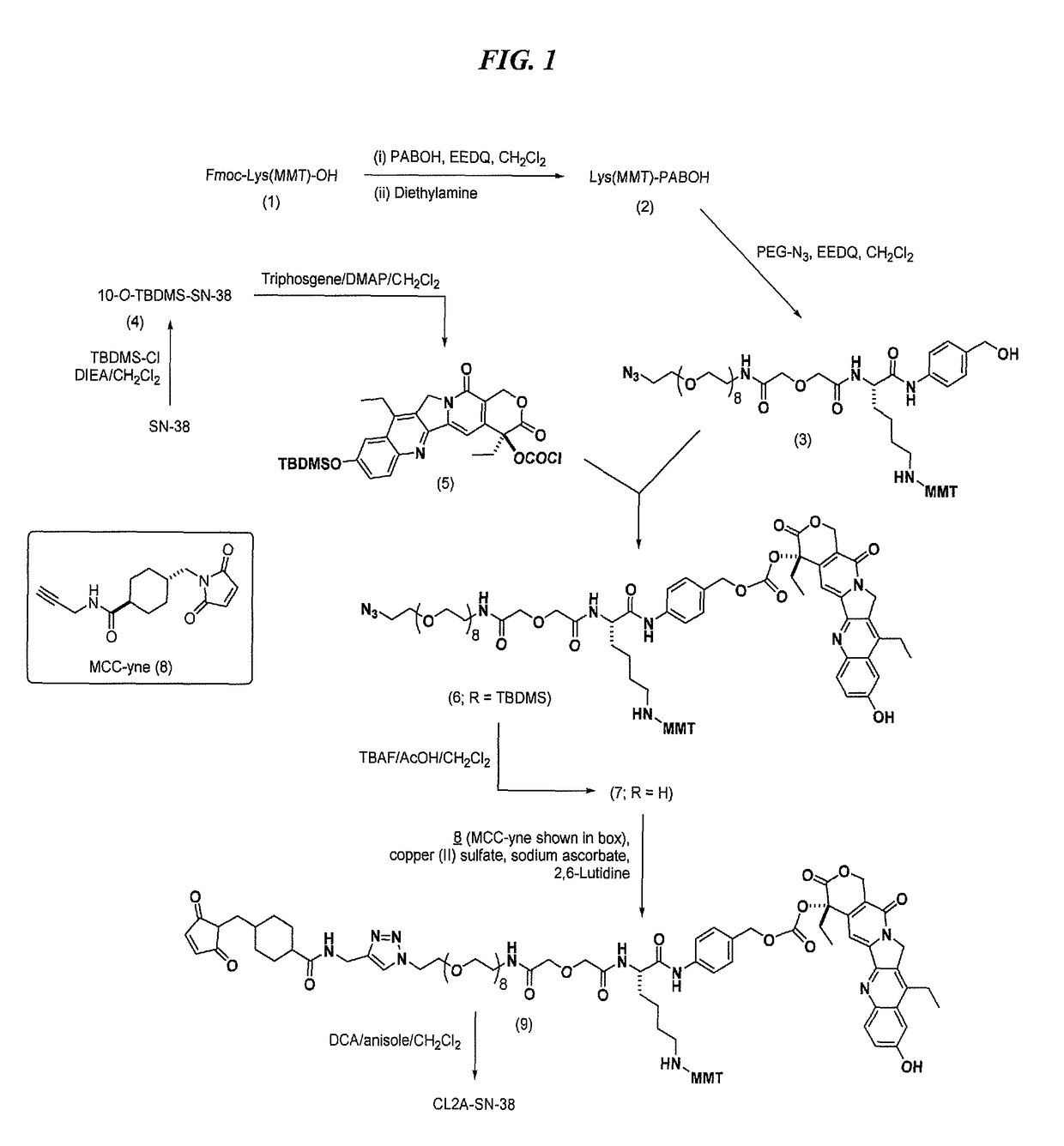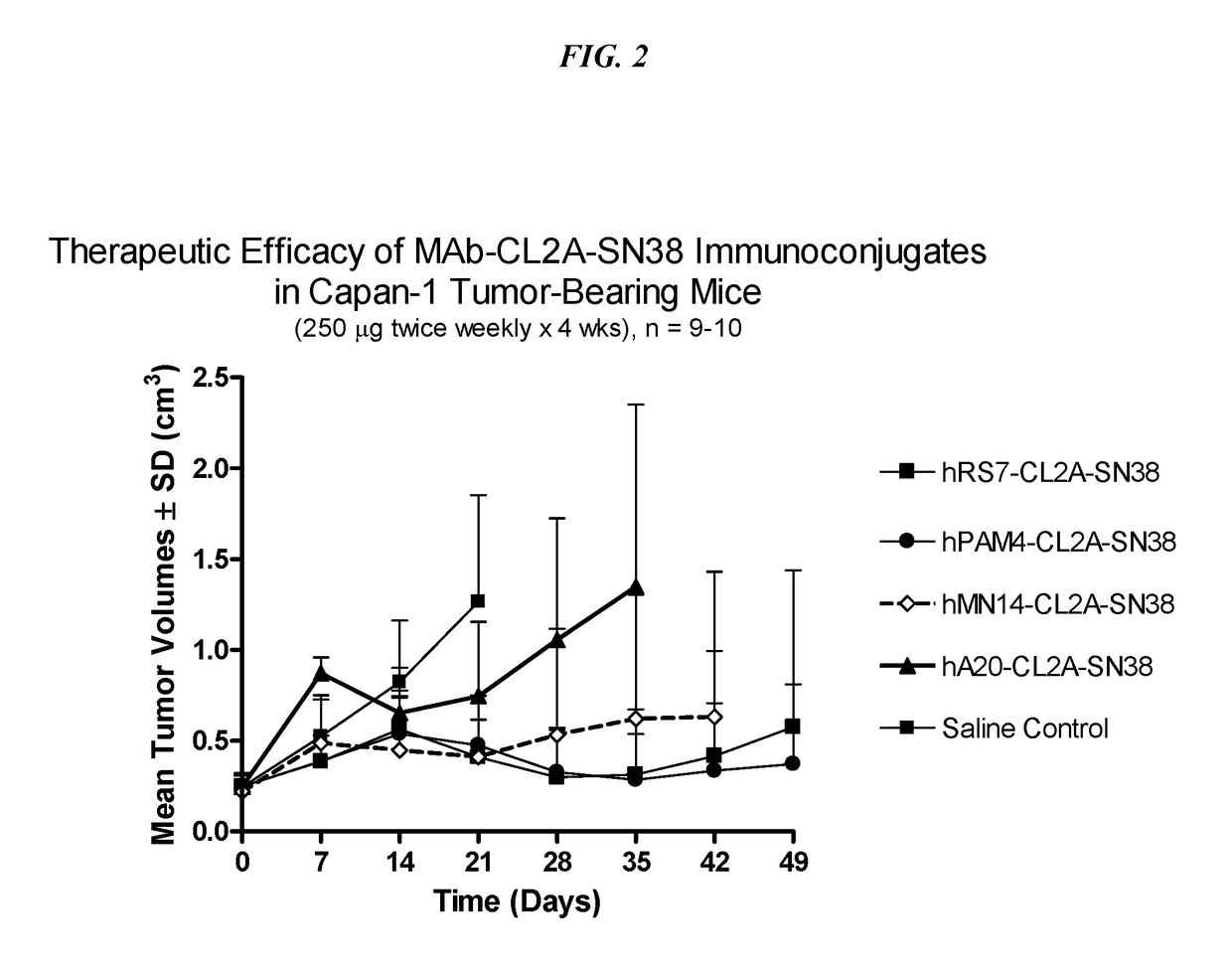Antibody-SN-38 immunoconjugates with a CL2A linker
a technology of immunoconjugates and antibodies, applied in the field of antibodysn38 immunoconjugates with a cl2a linker, can solve problems such as product quality, and achieve the effects of high protein recovery, improved yield and/or efficiency
- Summary
- Abstract
- Description
- Claims
- Application Information
AI Technical Summary
Benefits of technology
Problems solved by technology
Method used
Image
Examples
example 1
Preparation of CL2A-SN-38
[0278]A preferred reaction scheme for synthesis of CL2A-SN-38 is shown in FIG. 1. A previous version of the synthetic protocol, described in U.S. Pat. No. 9,107,960, was the basis for the improved protocol shown in FIG. 1. The substrates, intermediates and reactions disclosed in U.S. Pat. No. 9,107,960 are discussed in the present Example. Further improvements to the protocol of U.S. Pat. No. 9,107,960, incorporated in FIG. 1, are described in the following Examples.
[0279]Preparation of O-(2-Azidoethyl)-O′—[(N-diglycolyl-2-aminoethyl)-Lys(MMT)-PABOH]heptaethyleneglycol (intermediate 3): In a 500-mL single-neck flask, commercially available Fmoc-Lys(MMT)-OH (16 g), p-aminobenzyl alcohol (3.26 g) and EEDQ (6.52 g) were added, followed by anhydrous dichloromethane (80 mL). After stirring overnight, diethylamine (25 mL) was added, and after a further 6 h, the reaction mixture was concentrated to a volume of ˜50 mL. This was diluted with heptane, and the solution...
example 2
Improved Protocol for Synthesis of CL2A-SN-38
[0283]While the synthetic protocol disclosed in Example 1 above is suitable for large-scale preparation of CL2A-SN-38, further improvements are disclosed herein that were not known and could not have been predicted as of the filing date of U.S. Pat. No. 9,107,960.
[0284]The CL2A linker disclosed herein comprises a PEG moiety containing a defined number of PEG monomers. As shown in FIG. 1, in a preferred embodiment the number of PEG monomers used in the linker is eight. However, alternative embodiments within the scope of the invention may utilize a number of PEG monomers between 1-30, more preferably 1-12, more preferably 6-10, more preferably 8.
[0285]There are 3 primary stages in which process improvements were made: (a) in the conversion of intermediate 6 to intermediate 7; (b) in the conversion of intermediate 8 to intermediate 9; and (c) in the conversion of intermediate 9 to intermediate 10.
[0286]Yield Improvement in the Preparation o...
example 3
Use of 1.1 vs. 1.4 Equivalents of Tetrabutylammonium Fluoride (TBAF) for Desilylation of Intermediate 6 to Intermediate 7
[0298]The crude intermediate 6 (13.78 g; 0.873 mmol) dissolved in 14 mL of DCM was cooled and treated with 1.4 equiv of 1 M tetrabutylammonium fluoride (TBAF) containing acetic acid (0.126 g), with the reaction mixture maintained at ≤20° C. After 1 h, the reaction mixture was washed with 0.25 M citrate buffer, pH 6 (3×10 mL), water, and 5% sodium chloride solution, and dried over anhydrous sodium sulfate. HPLC showed 85.5% purity for the crude product 7, with impurities at four peak positions as follows: 1.0% (relative retention time or RRT of 0.79), 2.4% (RRT of 0.864), 1.5% (RRT of 0.94) and 3.7% (RRT of 1.162). When the same reaction was conducted using 1.1 equiv of 1 M TBAF, HPLC purity of the product improved slightly to 88.2%, but the impurities dropped significantly: 0.3% (RRT of 0.79), 0.7% (RRT of 0.864), 0.8% (RRT of 0.94) and 2.4% (RRT of 1.162). Improv...
PUM
| Property | Measurement | Unit |
|---|---|---|
| pH | aaaaa | aaaaa |
| pH | aaaaa | aaaaa |
| structure | aaaaa | aaaaa |
Abstract
Description
Claims
Application Information
 Login to View More
Login to View More - R&D
- Intellectual Property
- Life Sciences
- Materials
- Tech Scout
- Unparalleled Data Quality
- Higher Quality Content
- 60% Fewer Hallucinations
Browse by: Latest US Patents, China's latest patents, Technical Efficacy Thesaurus, Application Domain, Technology Topic, Popular Technical Reports.
© 2025 PatSnap. All rights reserved.Legal|Privacy policy|Modern Slavery Act Transparency Statement|Sitemap|About US| Contact US: help@patsnap.com



